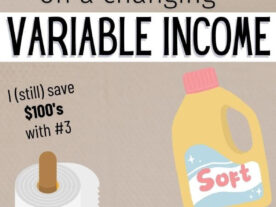9 Ways to Save with a Variable Income
For those with variable income, whether you are in sales, are part of the gig economy, or work part-time hours that vary, your monthly income can fluctuate greatly.
You might only earn enough to have cereal-for-dinner one month and then more than enough for a fancy-steakhouse-dinner the next.
Trying to navigate the up-and-down months can be challenging if you are living paycheck to paycheck.
Does this sound familiar? If so, you need to focus on saving money to add a buffer for those months with less income.
Don’t fret! Use these tips to save and get ahead when you have a variable income.
1. Pay Yourself First
It’s only normal to put others before ourselves. However, that will have to change if you want to build a decent nest egg.
The first thing you must do is recognize your need to save money. It’s easier than you think when you establish appropriate priorities.
With a variable income, it is critical to save enough to create a cushion. The way you do this is to pay yourself first. Don’t confuse this with “treat yourself first.”
Paying yourself first doesn’t mean you go out and reward yourself with your paycheck. Instead, it means before you pay anyone else (aka bill collectors), you deposit money into your savings account.
If you make it the first thing you always do when you receive money, your savings will grow and grow and grow and grow.
Paying yourself first gives you options when money is tight.
Free Workshop – Join our free Simplify Money Workshop
The *only* way to save money is to spend less than you earn. That means you need to decrease your expenses or increase your income.
We want to help you do both.
Join our FREE Simplify Money Workshop to learn the fundamentals of growing wealth. Because when you can spend less than you earn, your money has no choice but to grow. You will build your savings and pay down debt.
What’s more? We’ve got a bunch of free money-hacks to share with you:
- Hacks to lower your monthly bills
- Hacks to spend less on debt
- Hacks to start investing
- Hacks to increase your income by $20/month (with no extra effort)
This workshop has everything you need to accomplish the cardinal rule of personal finance: keep your income over your expenses.
Join our free 5-day Simplify Money Workshop, and start growing your wealth today.
2. Calculate Essential Expenses
There are some expenses you must pay (whether you want to or not) each month.
Gather your bills and statements so you can take a good hard look at your recurring essential expenses, like rent or mortgage, utilities, food, car payment, and transportation.
Calculate the minimum amount of money you need to cover these expenses each month. Ideally, you will earn enough money to cover these expenses and then some.
When your income isn’t consistent, this might not always be the case. But, if you know how much you need, you can make plans to save more during your profitable months.
3. Spend Less Than You Earn
When you deal with an income that fluctuates on a monthly basis, there will be times when you earn more than others.
It’s super tempting to splurge, but you’ll regret it when you have a month when income isn’t so great.
To overcome this challenge, make it a goal to spend less than you earn each month no matter how much you bring in.
Do this, and you will have money to save. What you don’t spend gets deposited.
Open a CIT Savings Builder Account
Want to set yourself up for savings success and be better prepared for retirement?
Make it easy! The CIT Savings Builder high-yield savings account is the perfect tool to kick-start your savings journey.
You only need a $100 opening deposit, which is great when you’re just starting.
And here’s the kicker: If you deposit at least $100 every month, you’ll earn the top-tier interest rate on your account balance.
See the banner below for the current top APY tier.
Pro Tip: Set up an automatic monthly transfer to your CIT Savings Builder account to make regular saving a no-brainer.
Open Your CIT Savings Builder account now and get started.
4. Save More on Those Big Months
When we have a big month, we tend to breathe easier. These months provide opportunities to save more.
Let’s say you usually bring in $4,000 a month, but this month you brought in $6,000. How should you allocate the extra income?
It would be easy to convince yourself you did a good job, so you deserve to treat yourself. Avoid that kind of thinking.
Instead of spending the extra cash on stuff you don’t really need, save it! This will give you an extra cushion to cover expenses during the slower months.
Deposit a chunk of it in your emergency fund and a little toward your retirement.
5. Live on Your Average Monthly Income
If your variable income is based on commissions, bonuses, or side gigs, figure out what you make a year and try to live off your annual income.
You might earn different amounts month-to-month, but you tend to earn around the same amount annually.
If this is the case, take your annual income, divide it by 12, and you have your average monthly income.
Create a monthly budget based on this amount, and make sure there is some money for your savings.
Let Trim Lower Your Expenses
Don’t put up with high prices for cable, internet or phone services any longer.
With Trim, you can sit back and let someone else fight to lower your bills.
Trim’s experienced negotiators will work on cutting those bills.
If they save you money, you will keep 66% of your first year savings and then 100% every year thereafter.
You won’t be charged a cent unless Trim saves you money.
Please note that Trim takes their payment immediately.
For example, if Trim saves you $10/month, they will request their 33% fee ($40) right away.
But you keep 100% of the savings after that.
Sign up for Trim to lower your bills
6. Use the Percentage System to Budget Your Money
After you calculate your average monthly income, one way to budget your money is to use a percentage system.
On popular budgeting method is the 50/30/20 system. With this model, you will budget:
- 50% for your needs
- 30% for your wants
- 20% for savings
If you want to be ambitious, try the 50% model:
- 25% for taxes (If you are a freelancer, you don’t get taxes taken out of your paycheck. You want to pull this money out of your paycheck and set it aside, or else it is going to really hurt come tax time.)
- 10% for your emergency fund
- 10% for retirement
- 5% for other savings goals (such as vacations)
If you follow this percentage system, you will have 50% to live off after paying yourself and paying taxes.
Empower – Effortless Budgeting and Saving
The percentage budgeting models are centered around saving money.
Build a budget to live on less and save what remains.
With Empower, you are held accountable to your savings goals.
You will tell Empower exactly how much money you want to save every week (maybe it’s $50/week).
Then like clockwork, $50 will transfer from your checking account to your savings account automatically every week, only when you can afford to save.
That’s not to mention their streamlined budgeting tools, human coaching, spending recommendations, and more.
If you are serious about saving money, allow Empower to hold you accountable.
Set your money on the path towards success with the Empower app today.
7. Watch Your Savings
You are in charge of your savings. Pay attention and see if it is growing how you’d like.
If you reach a savings goal, such as a fully funded emergency fund of three to six months of income, lessen the percentage of each paycheck you put into this savings category.
On the other hand, if you notice you have been unable to save as much as you’d like, adjust your budget to spend less. Do this and your savings will grow.
8. Invest Your Savings
In addition to creating a buffer for expenses and saving for emergencies, it is important to invest your savings.
You don’t want to hold on to this money when it has the potential to grow. Look for investment opportunities and retirement plans that will allow you to grow your wealth.
Some of the ways you can invest include an employer’s 401(k) plan, a traditional or Roth IRA, mutual funds, and stocks.
9. Don’t Get Discouraged
Saving money isn’t always easy – especially when you can’t rely on a stable income. But that doesn’t mean it’s impossible!
People with variable incomes have found ways to save money, pay off debt, and grow their wealth. You can, too!
You can save more on a variable income when you:
- Pay yourself first.
- Identify what you must earn at a minimum.
- Save your extra cash to build a buffer.
SAVE MORE MONEY! READ THESE NEXT….
Want to save these tips for later? Click here to pin this post!
Be sure to follow us on Pinterest for more money-saving life hacks!










